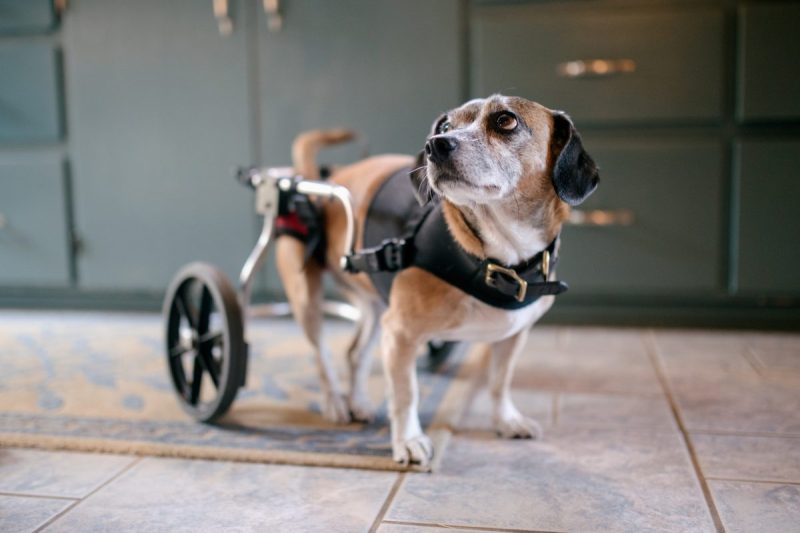Paralysis in dogs happens when the central nervous system’s ability to coordinate the body’s movements is diminished or completely lost.
All cases of paralysis in dogs, even rare cases of temporary paralysis, are a cause for concern and warrant a vet visit without delay. If you see the signs in your dog, consult your veterinarian immediately for a proper diagnosis and treatment. Here’s what you should know about the symptoms, causes, and treatments of paralysis in dogs.
Symptoms of paralysis in dogs
Usually, the brain, spine, nerves, and muscles work together, allowing a dog to move as they should. However, damage to the nerves that carry messages between the brain and the body can cause the complex communication paths to break down, causing paralysis. The symptoms of paralysis in dogs can vary based on the cause and which nerve communication pathways suffer damage.
The area of dogs’ bodies most often affected is the hind legs. However, many other areas may be affected, including the facial muscles, the front legs, or the muscles that control defecation and urination.
If you see any of the symptoms below in your dog, then you should consult your vet right away:
- Inability to move back legs or all four legs
- Dragging rear legs when walking
- Signs of pain in the neck, spine, or legs
- Inability to control urination or defecation
- Constipation
- Inability to urinate at all
- Inability to blink
- Discharge or irritation of the eyes
- Drooping eyelids
- Dropping food from the mouth
- Drooling
- Head tilting
- Weakness
- Abnormal eye movement (ataxia)
- One eye looks larger than the other
- Loss of throat or voice control
- Vomiting or regurgitating
- Respiratory problems
- Loss of muscle mass
Causes of paralysis in dogs
Several conditions can cause paralysis in dogs. Anything that breaks down communication between the brain and body can then lead to a loss of coordination and an inability to move.
Some breeds are more likely to suffer from paralysis than others. Dachshunds, Basset Hounds, and dogs who have long backs and are low to the ground are more at risk for intervertebral disc disease, a condition where ruptured vertebral discs put pressure on the spinal cord.
Additionally, some breeds like the Boxer, Chesapeake Bay Retriever, and German Shepherd have a genetic predisposition for degenerative myelopathy, a slow-acting disease that attacks the nerves in senior dogs and causes hind leg paralysis.
Here are several other factors that can lead to paralysis in dogs:
- Dermacentor tick bite (“tick paralysis” caused by the neurotoxin in the saliva of female ticks)
- Meningitis
- Rabies
- Distemper
- Diskospondylitis
- Slipped discs
- Spinal infection, inflammation, or injury
- Spinal or vertebral deformation
- Polymyositis
- Polyneuropathy
- Neosporosis
- Severe exposure to pesticides or insecticides (those that contain organophosphates)
- Embolus (blocked blood flow to the spine)
- Aortic embolus (blocked blood flow to the hind legs)
- Central nervous system tumors or cancer
- Botulism
- Myasthenia gravis
- Hypothyroidism
- Fibrocartilaginous embolism (part of a spinal disk breaks off and blocks blood flow)
Treatments for paralysis in dogs
Treatment for dog paralysis depends on the cause of the condition. Some cases can be resolved with surgery. This may be an option when there’s nerve damage or if tumors are present, but this is determined on a case-to-case basis. The vet may then prescribe acupuncture, massages, stretches, and heat therapy to aid recovery.
Vets can treat some fungal and bacterial infections with anti-fungal drugs and antibiotics. Tick paralysis is usually resolved when the tick is removed, and antibiotics may also be prescribed. Other conditions require further complicated treatments and physical rehabilitation, and sometimes an affected limb must be amputated.
However, in some cases, all that can be done is symptom management. In these situations, the vet may prescribe pain medication, and they may insert a catheter to allow a dog to empty their bladder. Anti-inflammatory drugs can also reduce some inflammation, and slings or dog wheelchairs may prevent affected limbs from dragging.
Recovery can also vary a lot depending on the cause and the dog’s response to treatment. It is important to follow veterinary guidelines for further care and monitor the dog’s condition and progress.

